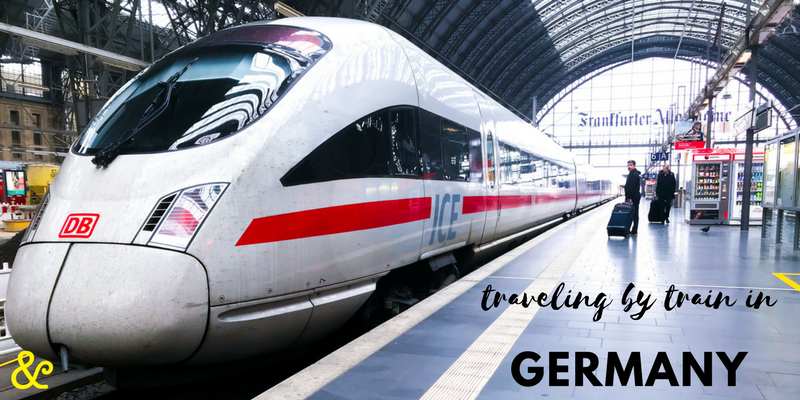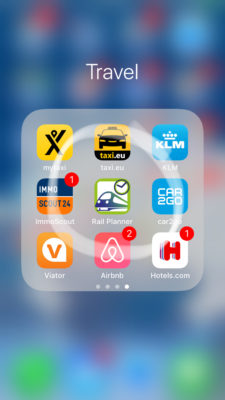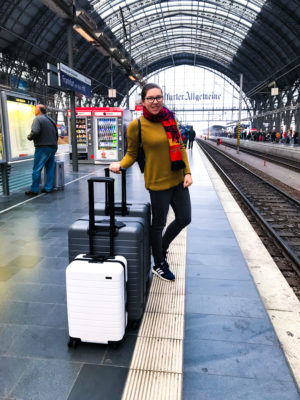
European train travel is MAGICAL.
High speed trains. Trams from a sleepy corner of town to the bustling city center. Interconnected countryside and city, state and country. I could have hopped on a train in Munich and emerged 10 hours later in London (I didn’t, though. Maybe next time!). It takes at least that amount of time to get from Los Angeles to San Francisco by train. Is that a testament to just how large California is? Yes, absolutely – but Munich to London is approximately a 700 mile drive, whereas LA to SF is a mere 350 – 400 mile journey.
But, of course, as convenient and easy to use as the rail system turned out to be, it took Sohrab and me a little bit of time to dig in and get used to it. After all, coming from Los Angeles, the idea of being able to step out of our hotel, walk a few yards, and board a train to somewhere as far as Frankfurt or as close as the Theresienweise (read: Oktoberfest!) was as foreign to us as Germany itself. A strange but very welcome concept, I assure you. And so, I am here to share with you our (small) trials and tribulations, our triumphs, and our tips for the next time you plan to explore Germany.
Plan your trip
While the system allows you to be spontaneous, if you’re traveling a longer distance (or on specific routes/types of trains… more on that in a minute), it might be worth it for you to get a reservation (in addition to your rail pass) for your preferred time.
 Apps like Apple Maps don’t currently support train travel in Germany (drat!), so your best bet is to download an app called Rail Planner. This allows you to see the rail schedule for the entirety of Europe – all offline! That means that if you’re hopping from Wi-Fi to Wi-Fi like I did, or you’re just in a bad signal area, you don’t have to worry about riding the rails blind. You can plan your trip on the fly or days in advance! Perfect for a wanderer like me AND a planner like Sohrab!
Apps like Apple Maps don’t currently support train travel in Germany (drat!), so your best bet is to download an app called Rail Planner. This allows you to see the rail schedule for the entirety of Europe – all offline! That means that if you’re hopping from Wi-Fi to Wi-Fi like I did, or you’re just in a bad signal area, you don’t have to worry about riding the rails blind. You can plan your trip on the fly or days in advance! Perfect for a wanderer like me AND a planner like Sohrab!
Bahnhöfe (train stations), especially Hauptbahnhöfe (main train stations), act as a hub for the cities they serve. Staying right next to the main station in Munich made our trip so smooth; not only were we in a cultural center of the city, but we also had easy access to all of the others. We never needed, or wanted, a car!
That said, our transition from the car culture of Los Angeles to the public transit mentality of Germany wasn’t exactly the smoothest. Remember how I said it took a little while for us to get used to traveling by train? We had a reservation on an early train out of Frankfurt to Munich, where we had tickets for the Bayern Munich v. Mainz game later that day.
Well… due to a platform change and our inability to understand the loudspeaker in German OR English, we gleefully watched as our train departed and eventually realized what happened. So, we were out our reservation and hopped the next train that left within the hour. Since we didn’t have our reservation, we train-surfed – getting up every time we made a stop since we were sitting in someone else’s reserved seats without realizing it.
All’s well that ends well, though; we made it to Munich in time for the game and learned our lesson: don’t assume anything – but when something goes wrong, just go with the flow. Enjoy the ride, even if you end up sitting a few compartments away from your luggage. The whole thing felt dramatic (especially my frantic questioning of the attendant in German!), but all was well. Bayern won that night.
Get your passes
 One of the easiest and most affordable ways to hop on an inter-city train in Germany is by ordering a Eurail one-country train pass in advance of your trip. They’ll mail you a package that will get you in the mood for exploring, with little booklets that you’ll need to have on you when you board. If you choose first class like we did – which is absolutely worth the extra money! – these will act as your proof that you’re allowed to be in that compartment, as well as those seats, if you made a reservation.
One of the easiest and most affordable ways to hop on an inter-city train in Germany is by ordering a Eurail one-country train pass in advance of your trip. They’ll mail you a package that will get you in the mood for exploring, with little booklets that you’ll need to have on you when you board. If you choose first class like we did – which is absolutely worth the extra money! – these will act as your proof that you’re allowed to be in that compartment, as well as those seats, if you made a reservation.
The flexibility of the multi-day passes that you can order above is the perfect companion to the flexibility that the Rail Planner app gives you. We had first class 3-day passes, which meant we could get on any train within Germany (not tram, which is like the Metro) on any 3 days within a month. Since we were there for two weeks, this worked out perfectly – and though we had everything planned before we left LAX, we didn’t have to. The only things we really needed to plan ahead for in terms of train travel were the reservations.
Make your reservations
Do you need to make it to the Bayern Munich game like we did? Do you want guaranteed seats in first class?
Then reservations are for you!
You can book your reserved seats when you buy your Eurail pass. They are highly recommended by the company for certain long distance rides, and you should do it between 2 months and 7 days before your trip to make sure you get a spot. So, go! Reserve your seats! I’ll wait here.
When in doubt, take the train
I think the most impressive part about train travel in Germany was just how freeing it feels. The system’s seemingly unlimited reach gives anyone the flexibility to go where they’d like without the need to spend hours behind a wheel. Everything is so interconnected, it brings out the explorer in me. Still not convinced? Come on a journey with us:

